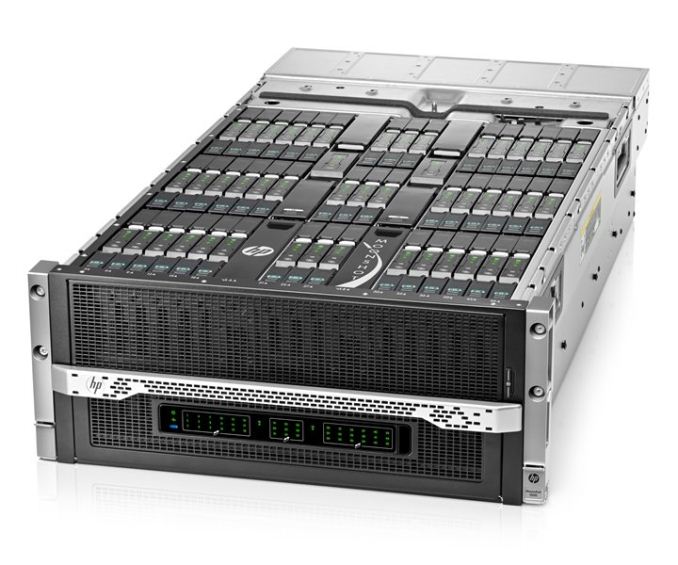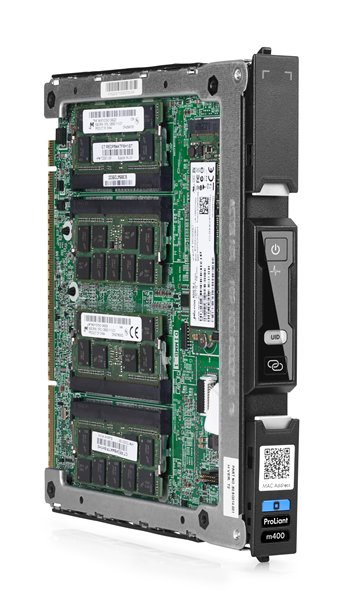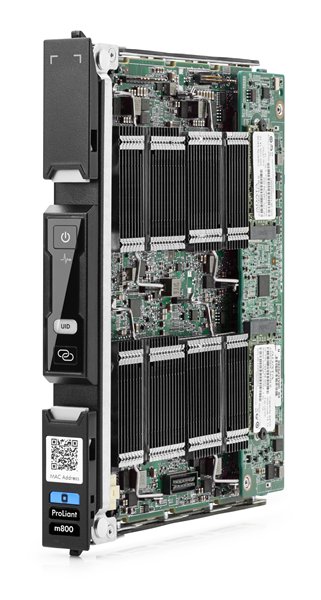HP, AppliedMicro and TI Bring New ARM Servers to Retail
by Stephen Barrett on September 30, 2014 9:19 AM EST- Posted in
- IT Computing
- HP
- Arm
- TI
- AppliedMicro
- SoCs
- server
- ARMv8

Yesterday HP announced retail availability of two ARM based servers, the ProLiant m400 and m800. Each are offered in a server cartridge as part of the Moonshot System. A single 4.3U Moonshot chassis can hold 45 server cartridges. Usually higher numbers mean better, but in this case the m400 and m800 are so significantly different I wouldn’t consider them competitors. The m800 is focused on parallel compute and DSP, while the m400 is focused on compute, memory bandwidth, IO bandwidth and features the first 64-bit ARM processor to reach retail server availability.
| HP ProLiant ARM Servers | |||||||||||
| m400 | m800 | ||||||||||
| Processors | 1 | 4 | |||||||||
| Processor |
AppliedMicro X-Gene Custom 64-bit ARMv8 |
TI KeyStone II 66AK2H Cortex-A15 ARMv7A + DSP |
|||||||||
| Compute cores per processor |
8 CPU |
4 CPU 8 DSP |
|||||||||
| Clock Speed | 2.4 GHz | 1.0 GHz | |||||||||
| Cache Memory |
Each core: 32KB L1 D$ and I$ Each pair: 256KB L2 All cores: 8MB L3 |
Each DSP core: 1MB L2 | |||||||||
| Memory |
Quad Channel 8 SODIMM Slots DDR3-1600 Low Voltage Max: 64GB (8x8GB) |
Single Channel 4 SODIMM Slots DDR3-1600 Low Voltage Max: 32GB (4x8GB) |
|||||||||
| Network Controller | Dual 10GbE | Dual 1GbE | |||||||||
| Storage | M.2 2280 | M.2 2242 | |||||||||
| PCIe | 3.0 | 2.0 | |||||||||
Starting with the m400, HP designed in a single AppliedMicro X-Gene SoC at 2.4 GHz. AppliedMicro has been discussing the X-Gene processor for several years now, and with this announcement becomes the first vendor to achieve retail availability of a 64-bit ARMv8 SoC other than Apple. Considering Apple doesn’t sell their processors stand-alone, this is a significant milestone. AppliedMicro has significantly beaten AMD’s A1100 processor to market, as AMD has not yet entered production. Marquee features of the X-Gene SoC include 8 custom 64-bit ARM cores, which at quad-issue should be higher performance than A57, quad channel DDR3 memory, and integrated PCIe 3.0 and dual 10GbE interfaces. Look out for a deep dive on the X-Gene SoC in a future article.
The m800 is a 32-bit ARM server containing four Texas Instruments KeyStone II 66AK2H SoCs at 1.0 GHz. Each KeyStone II SoC contains four A15 CPU cores alongside eight TI C66x DSP cores and single channel DDR3 memory, for a total of 16 CPU and 32 DSP cores. IO steps back to dual GbE and PCIe 2.0 interfaces. It is clear from the differences in these servers that m400 and m800 target different markets. There isn’t yet a best-of-both-worlds server combining the core count and memory + IO interfaces of the m400 and m800 together.
Each server is available with Ubuntu and IBM Informix database preinstalled, and will be demonstrated at ARM TechCon October 1-3 in Santa Clara, California.
Source: HP












33 Comments
View All Comments
OreoCookie - Friday, October 3, 2014 - link
If you base your performance estimate on Geekbench, Apple's A8 should be roughly as fast as a 2.9~3 GHz Core 2 Duo from 2008: the A8 reaches a score of http://www.phonearena.com/news/Geekbench-test-show...">about 2920 while the Core 2 Duo E7500 (2.93 GHz) scores http://browser.primatelabs.com/processor-benchmark...">2974 in the multicore 64 bit benchmark. On the single-core benchmark, the A8 is a hair's breadth faster (1633 points vs. 1614 for the Intel).But both, the A7 and A8 are faster than a 2006 era Core 2 Duo, though, the latter in its T7500 incarnation only scores 1262 and 2126.
Roughly speaking, Apple's SoCs deliver the same level of CPU performance as a notebook CPU that's 6 years older (and I think this has been true for a while).
FunBunny2 - Tuesday, September 30, 2014 - link
The interesting bit is the Informix pre-install. RDBMS, done smart, falls in the "embarrassingly parallel" quadrant of computing. Informix is a niche DB with some experience in parallel:http://programmingexamples.wikidot.com/19-informix...